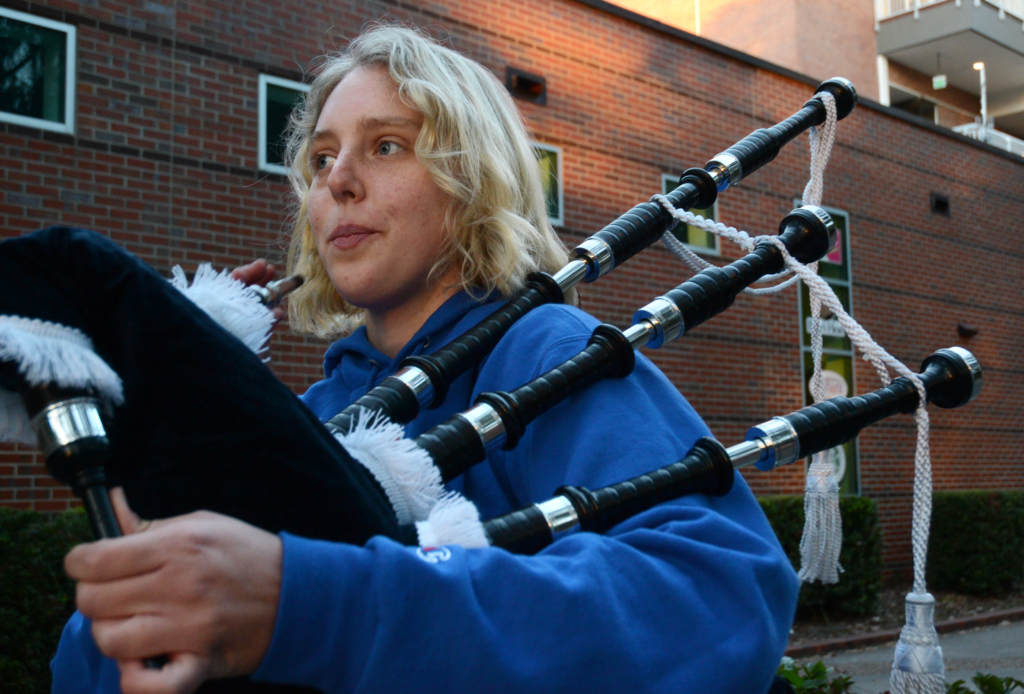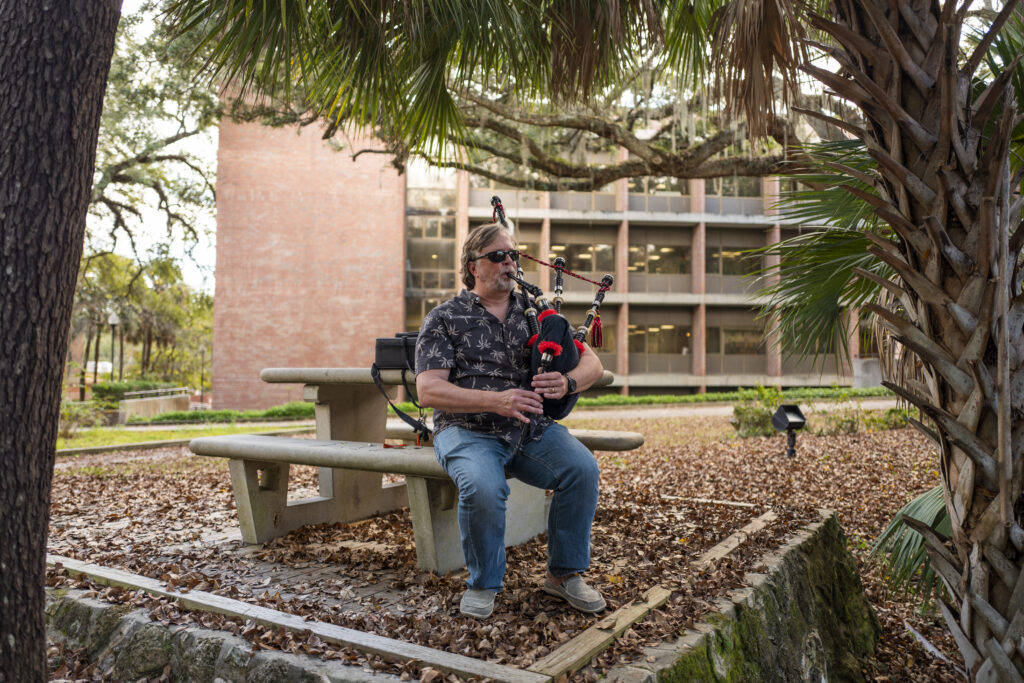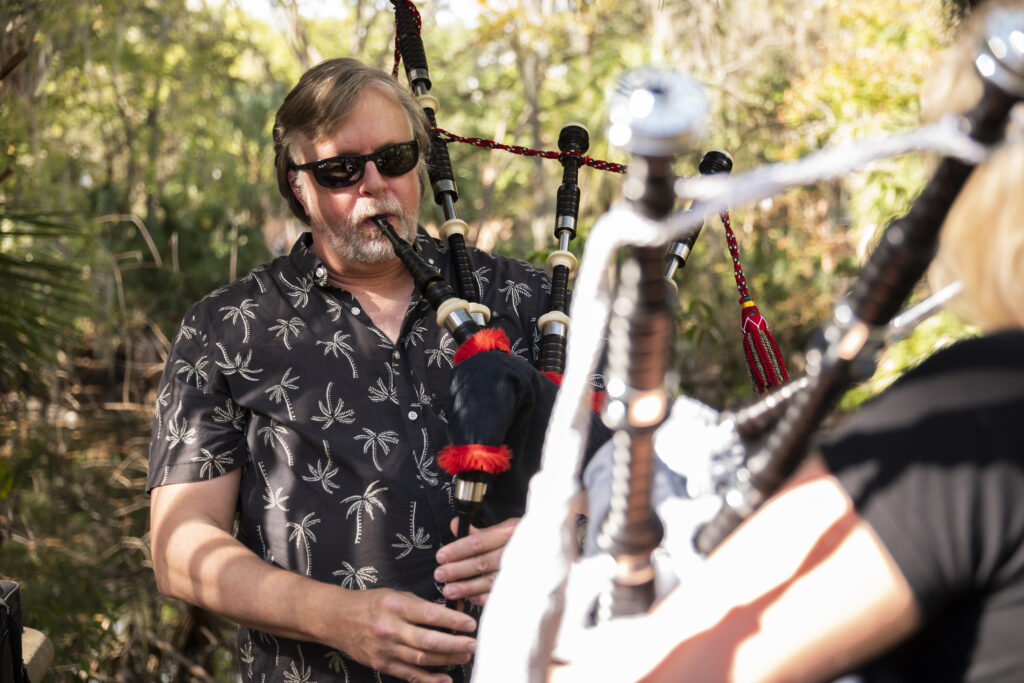Two student bagpipers and their mentor breathe aspirations into reality

Schneider and Maze think back to their first email exchange and feel proud of where their goals have taken them. They want to sustain the sounds of pipes on campus and inspire more students and faculty through song. (Giuliano De Portu/Atrium)
Feb. 7, 2022 | Story by Abigail Hasebroock
Rays of afternoon sun cast golden beams on the hands of two freshmen women. Their determined fingers move methodically up and down the chanters of their bagpipes.
Mary Schneider and Megan Houser breathe life into their instruments, which, on this winter day, drown out even the chimes of the University of Florida’s 157-foot-tall Century Tower. Their melodies crash through conversations among classmates. Bikers weaving through foot traffic turn their heads. Squirrels and birds scatter.
Schneider wears a blue sweatshirt with a Gators logo emblazoned on the front and black tennis shoes as she plays; Houser, a textured brown sweater and high tops decorated with daisies. They don’t fit the bagpiper stereotype — men wearing skirts in the Scottish Highlands — but they play with pride nonetheless.
And despite the surroundings of their college campus, the two are working to bring the historically rich instrument they love into the spotlight.
But bagpipes already lurk in more places than most would think. The Glasgow Climate Change Conference in November ushered in a bagpipe performance for its opening ceremony. AC/DC’s “It’s a Long Way to the Top (If You Wanna Rock ‘N’ Roll)” features the instrument’s triumphant melodies at one minute and 25 seconds in. The New York City Fire Department Emerald Society Pipes and Drums group debuted their bagpipes at the 2015 Macy’s Thanksgiving Day parade. And a scene in the 2021 film “Dune” caught viewers off guard as a character began to play an unexpected pipe ballad.
Schneider isn’t shy about playing on campus for anyone to hear. She has a soft-spoken nature and a self-proclaimed case of stage fright, but the boisterous blare emboldens her. Her go-to spots to practice by herself are by the Ben Hill Griffin Stadium or the courtyard surrounding her dormitory — otherwise known as her backyard.
Any nerves Schneider carries are usually channeled into her performance. She doesn’t mind that the sound amasses attention. People often stop to watch. Some even clap when she pulls away from her bagpipe.
Among palm fronds and fallen leaves, she hoists the instrument up and begins to play. Bagpipes aren’t typically more than a few pounds, and she says they don’t feel too heavy. But the navy blue bag and silver tassels that ornament Schneider’s set, combined with the powerful sounds it produces, create the illusion of an instrument whose weight would shatter scales.
The sound thunders from as far as 10 miles away. Even when Schneider practices alone, the music pulsates across campus. It feels freeing.

Mary Schneider pauses amid a practice session with Megan Houser as the two play on the University of Florida campus. Schneider aims to practice a few times a week, and when she does, it typically takes place outside where passersby can enjoy the melodies. (Houston Harwood/Atrium)
Bagpipes have helped bring her out of her shell. But to Schneider, nothing beats practicing pipes with company.
In the fall semester, while students scurried to class and alligators floated atop campus ponds, Schneider and Houser often played together with plans of starting a bagpipe brigade.
The two women began playing in seventh grade and endured endless practices and performances throughout middle and high school at Berkeley Preparatory School in Tampa. They grin when they share stories about days in their school’s pipe band, reminiscing on trips to Boston and competitions at the Highland Games, a festival celebrating Scottish and Celtic culture that occurs in various cities around the world.
Neither Schneider nor Houser is Scottish or Celtic, but their school’s embrace of the culture spurred a spontaneous love for the instrument.
Neither woman is pursuing a degree in music, either. Houser studies natural resource conservation. Schneider, environmental science. But they never had any intention of abandoning their pipes, even though practicing has become more difficult than it was in high school.
The roar of the instrument swallows a room whole. Open spaces can’t contain the cacophony. So, Schneider often avoids creating the bold crescendos in her dorm room, which she shares with two other students. And while she considers playing outside, it’s not always feasible.
UF’s music program offers practice rooms, but Schneider says they are only accessible to students in the program.
“It’s a little frustrating,” she says. “You can’t use any of their facilities or any of their resources unless you’re a music major or minor, but you can’t major or minor in bagpipes.”
Houser and Schneider talk about their passion for playing bagpipes. (Anna Wilder and Ryelin Segars/Atrium)
At Florida universities, pipe bands are sparse. Carnegie Mellon University, a private research institution in Pittsburgh, is the only school in the United States that offers bagpipes as a major. Gainesville’s defunct University City Pipe Band hasn’t been active since 1998.
Schneider and Houser have embarked on their journey at UF as freshmen trying to create a platform for bagpipes on campus. They want to spread the joy they feel through the instrument.
With help from John Maze, a UF architecture professor and prolific pipe player, Schneider and Houser aim to revive the sounds of bagpipes on campus.
“It’s going to be a revolution,” Maze says. That certainty is what brought him, Schneider and Houser together.

Maze sits on a bench that looks over the pond greeting UF’s architecture building where he teaches. “Music is storytelling,” he said. “It’s the same way with architecture.” (Giuliano De Portu/Atrium)
Every third Tuesday of the month, Maze, who is also known as Bagpipe John, plays with his band, An Triúr, at Satchel’s Pizza. There, customers watch in awe as they get their fill of salty dough and cheese.
The Chieftains, an Irish Band that has won six Grammy Awards since its inception in 1962 and been praised for “reinventing traditional Irish music,” asked Maze to play with them three times between 2005 and 2013. But even though he’s taken the stage with world-famous performers before, one of his most long-withstanding bagpipe gigs takes place at his local library.
On the first day of an Alachua County Library book sale last fall, Maze played the pipes before the gates to the books were unlocked. He’s stuck with that tradition for so long he can’t remember how many years it has been since he started.
He even made a pit stop at the book sale on his wedding day.
“My wife wasn’t happy about that one,” he says. “I have played it in sickness and in health.”
His commitment to the craft captured the attention of Schneider, who first heard about Maze through a conversation with a student in her dorm. The student spoke of how Maze opened the first day of one of his general education humanities classes by playing the bagpipes. Schneider emailed Maze soon after.
“Since I’ve gotten to UF I’ve really been missing being part of a corps,” she wrote. “So, I was wondering if maybe you knew about any way to get involved with other pipers in Gainesville? Or do you know of any good, local teachers that could offer lessons?”
When Maze opened the message, he thought: “Yes, another victim!”

John Maze has been playing the bagpipes for more than two decades. He picked up a practice chanter on his way out of Los Angeles to teach at the University of Virginia for a few years before landing at UF. “I figured, what the hell, let’s do it,” he said. (Giuliano De Portu/Atrium)
After proclaiming his enthusiasm about stumbling upon a fellow pipe player, he outlined their next steps.
“So, here’s what we’re going to do,” he wrote. “You and I are going to form a piping Gators bagpipe club… I will be your faculty sponsor, and you and I can get the first UF Piping Gators (or whatever you want to call us) pipe band going!”
The two first met to practice in one of the UF School of Architecture classrooms.
“I have a lot of trouble practicing on my own,” Schneider says. “So, it’s nice to have something regular to keep me doing it.”
Houser joined them the following week. She didn’t have her own bagpipes, but Maze let her borrow a set.
A quality set of bagpipes can cost more than $1,000. Practice chanters, which are the reeds that players blow into and finger, can sell for about $30 a piece. The instruments are investments and are traditionally hand-crafted with sustainable materials to last for centuries.
But the instrument’s hefty price tag doesn’t need to be a hindrance to creating a pipe band or learning how to play.
If someone has a chanter, a healthy set of lungs and a few fingers, they can learn to play.
“You just breathe into the pipe, and it’s like a recorder,” Houser says. “Anyone could do it.”

Megan Houser holds her chanter, the part of a bagpipe that players blow into and finger to create sound, is easier and cheaper to acquire than an entire set of bagpipes and is a simple way to get acquainted with the instrument for anyone interested in learning to play. (Houston Harwood/Atrium)
Schneider doesn’t envision this group as existing exclusively for people who already know how to play. In high school, she taught other students and said she would love to continue instructing rather than act as a gatekeeper to the craft.
Interest is blooming. While practicing outside on a December afternoon, a student approached Schneider and Houser, drawn in by the languid lullaby of the song they played.
Schneider made sure he didn’t leave before scrawling his name and email on a slip of paper. She was lucky enough to get the names and emails of two of his friends, too.
The encounter resulted in an unexpected yet electrifying realization that Schneider and Houser’s dream could soon become a reality.
And about four months after Schneider’s initial email to Maze, it did. On Jan. 14, the official Orange and Blue Pipe Band at UF was born.
“I knew wherever I went, I’d start a pipe band,” Schneider says.
One day, the trio hopes to play at a Gators football game in the stadium.
They might don orange and blue kilts. They might play before the game or during a halftime show — or both. The hypnotic buzz could sweep through the stadium, generating spirit among players and fans as the bagpipes carry the team to victory.
After every football game, the crowds cling to one of two sides of the street that snakes out of the stadium so the Gators marching band can pass through campus. Soon enough, a pipe band might lead the way. That is the hope Schneider and Houser harbor in their hearts; a hope that is as big as their music.